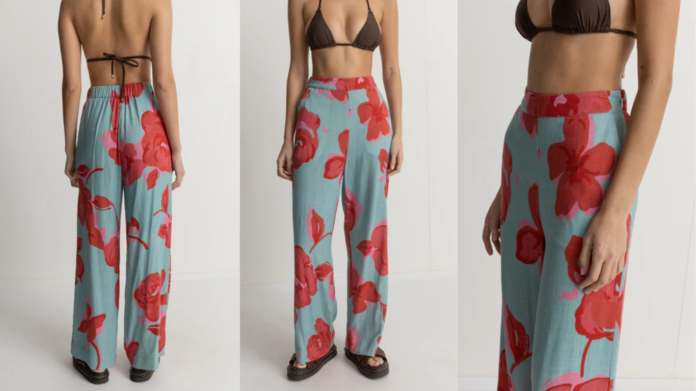Introduction
Floral motifs have long been used in fashion to reflect many cultures and tastes. Floral patterns represent nature’s beauty and human innovation. Flower pants have become a fashion staple. This article examines floral designs in clothes from classic to modern.
The Origins of Floral Patterns
Ancient Beginnings
Floral motifs originated in ancient civilizations thousands of years ago. Floral designs on ancient Egyptian fabrics and artefacts symbolized fertility and vitality. Egyptian art represented the lotus blossom as a symbol of rebirth and the sun. Ancient Greeks and Romans used floral designs on ceramics and clothing to highlight nature’s beauty and importance.
The Middle Ages and Renaissance
Floral designs spread over Europe in the Middle Ages. For nobles, elaborate floral textiles were embroidered with gold and silver threads. Floral designs were popular in fashion throughout the Renaissance due to a renewed interest in nature. Italian designers used bright colours and accurate floral renderings to influence fabrics. These age-made floral themes signify luxury and refinement.
The 18th Century: Floral Patterns in Rococo Fashion
Rococo Influence
Elegant patterns marked the French Rococo period (1715-1789). Dress accessories and home décor materials featured floral motifs throughout this time. Designers like François Boucher painted beautiful flower arrangements that influenced textiles. The French nobility loved flower motifs because of their pastel colours and gentle lines.
The Shift Towards Chintz
Chintz originated from India and became fashionable in Europe by the late 18th century. Chintz, with its vivid flower designs, was lightweight and breathable. Floral themes on clothes and furniture symbolized comfort and style. The British East India Company introduced chintz to Europe, sparking decades of flowery fashion.
The 19th Century: The Victorian Era and Floral Prints
Victorian Aesthetic
Floral designs flourished throughout the Victorian era (1837–1901). The Industrial Revolution improved textile printing, making floral motifs more affordable for the middle class. Floral dresses were fashionable because the era emphasized femininity and grace. Darker hues and elaborate patterns provided a romantic look, with flower motifs emphasizing purity and beauty.
The Influence of Nature
Nature and its beauty were valued more during Victorian times. Floral designs were popular when the Pre-Raphaelite Brotherhood praised nature. Floral designs on wallpaper textiles and paintings linked art and fashion. This era made floral designs popular in women’s apparel.
The 20th Century: The Rise of Floral Patterns in Modern Fashion
The Roaring Twenties
The Roaring Twenties broke with the traditional fashions of prior decades. This period saw a revival of floral designs in women’s apparel. The flapper dress often with flower designs symbolized freedom and self-expression. Designers like Coco Chanel included flower themes in their designs making them popular for modern women.
The Influence of Art Movements
Art trends like Abstract Expressionism and Pop Art influenced fashion in the mid-20th century. Designers experimented with vivid flower designs to create appealing images. Flowers were famous throughout the 1960s and 1970s psychedelic movement due to their bright colours and abstract interpretations. The culture of flower power linked peace and love to flowery designs.
The 21st Century: Contemporary Floral Fashion
Modern Interpretations
Modern flower motifs come in many ways. Designers explore digital printing to create more elaborate flower arrangements. Floral pants are adaptable and may be worn on runways and in streetwear. Designers today combine flowery designs with contemporary shapes to create eye-catching outfits.
The Role of Sustainability
Sustainability develops with fashion. Designers are employing organic materials and ecological colours in their production procedures. Floral designs developed from sustainable materials appeal to eco-conscious consumers and honour nature. This movement promotes environmental protection and flower beauty.
Conclusion
The history of floral patterns in fashion, especially flower trousers, is rich in cultural influences, creative movements, and socioeconomic developments. Floral patterns represent beauty, femininity, and inventiveness from ancient civilizations to current fashion runways. Floral motifs in modern fashion remind us of nature’s impact and textile design’s craftsmanship.
FAQs
What are flower pants?
Flower pants are usually composed of flowery fabric. They are flexible for informal and formal situations and available in wide-leg trousers, leggings, and joggers. Flower pants are popular because they offer colour and inventiveness to an ensemble, expressing the wearer’s flair.
When did floral patterns first appear in fashion?
Floral designs were employed in textiles and art in ancient Egypt and Greece. However, floral motifs were fashionable in European fashion throughout the Renaissance (14th to 17th century) and continued to evolve through the Victorian and 20th centuries.
Why are floral patterns significant in fashion?
Fashion uses floral designs to represent beauty, femininity, and nature. They convey feelings of growth, rebirth, and vigour. Floral patterns have long been used to communicate social position, cultural identity, and artistic expression in fashion.
How have floral patterns evolved?
Cultural and creative changes have shaped floral designs. Floral patterns have changed with fabric printing technology from elaborate hand-painted designs in the 18th century to bold abstract prints in the 1960s. Digital technology allows designers to create beautiful flower designs that reflect current trends and sustainability concerns.


